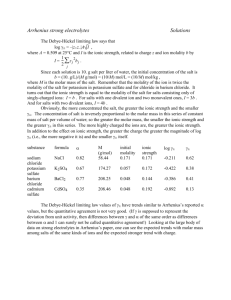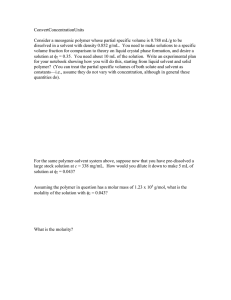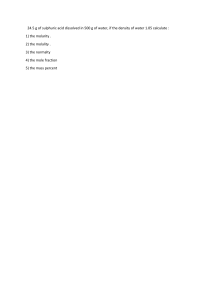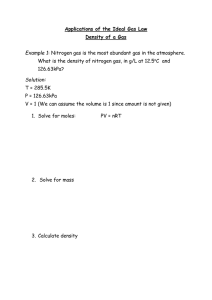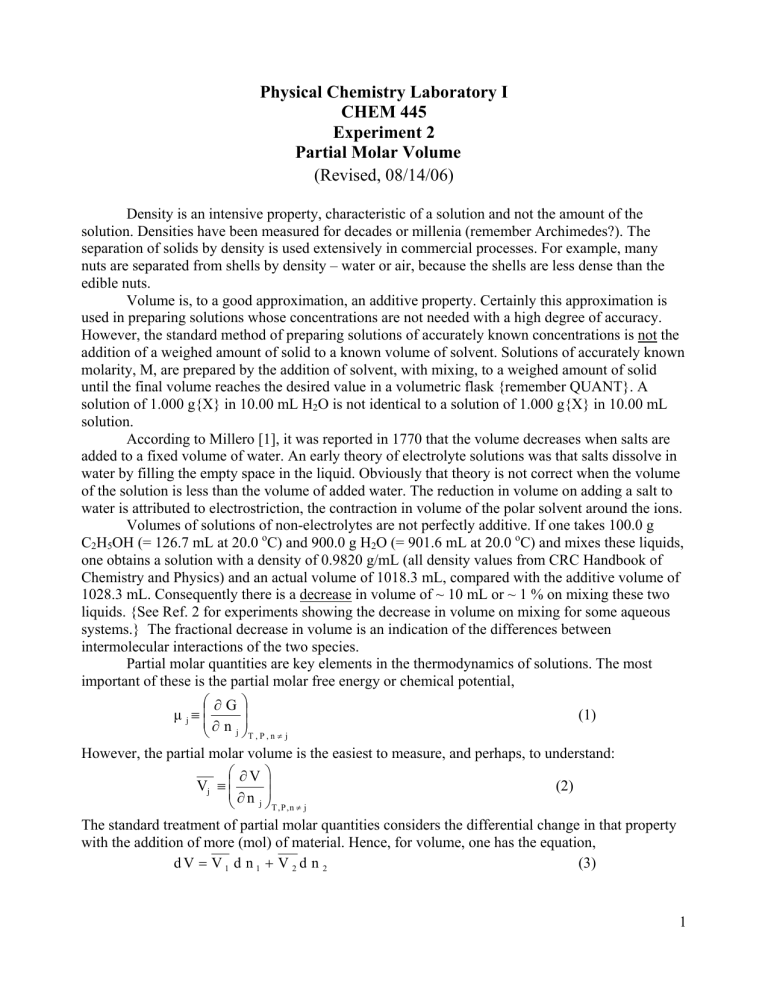
Physical Chemistry Laboratory I
CHEM 445
Experiment 2
Partial Molar Volume
(Revised, 08/14/06)
Density is an intensive property, characteristic of a solution and not the amount of the
solution. Densities have been measured for decades or millenia (remember Archimedes?). The
separation of solids by density is used extensively in commercial processes. For example, many
nuts are separated from shells by density – water or air, because the shells are less dense than the
edible nuts.
Volume is, to a good approximation, an additive property. Certainly this approximation is
used in preparing solutions whose concentrations are not needed with a high degree of accuracy.
However, the standard method of preparing solutions of accurately known concentrations is not the
addition of a weighed amount of solid to a known volume of solvent. Solutions of accurately known
molarity, M, are prepared by the addition of solvent, with mixing, to a weighed amount of solid
until the final volume reaches the desired value in a volumetric flask {remember QUANT}. A
solution of 1.000 g{X} in 10.00 mL H2O is not identical to a solution of 1.000 g{X} in 10.00 mL
solution.
According to Millero [1], it was reported in 1770 that the volume decreases when salts are
added to a fixed volume of water. An early theory of electrolyte solutions was that salts dissolve in
water by filling the empty space in the liquid. Obviously that theory is not correct when the volume
of the solution is less than the volume of added water. The reduction in volume on adding a salt to
water is attributed to electrostriction, the contraction in volume of the polar solvent around the ions.
Volumes of solutions of non-electrolytes are not perfectly additive. If one takes 100.0 g
C2H5OH (= 126.7 mL at 20.0 oC) and 900.0 g H2O (= 901.6 mL at 20.0 oC) and mixes these liquids,
one obtains a solution with a density of 0.9820 g/mL (all density values from CRC Handbook of
Chemistry and Physics) and an actual volume of 1018.3 mL, compared with the additive volume of
1028.3 mL. Consequently there is a decrease in volume of ~ 10 mL or ~ 1 % on mixing these two
liquids. {See Ref. 2 for experiments showing the decrease in volume on mixing for some aqueous
systems.} The fractional decrease in volume is an indication of the differences between
intermolecular interactions of the two species.
Partial molar quantities are key elements in the thermodynamics of solutions. The most
important of these is the partial molar free energy or chemical potential,
⎛∂G⎞
⎟
μ j≡ ⎜
(1)
⎜∂ n ⎟
j ⎠T , P , n ≠ j
⎝
However, the partial molar volume is the easiest to measure, and perhaps, to understand:
⎛ ∂V ⎞
⎟
Vj ≡ ⎜
(2)
⎜∂n ⎟
j
⎝
⎠T , P , n ≠ j
The standard treatment of partial molar quantities considers the differential change in that property
with the addition of more (mol) of material. Hence, for volume, one has the equation,
(3)
dV = V1 d n1 + V 2 d n 2
1
The partial molar volume of each component, V j , may be a function of concentration, but it does
not depend on the total number of moles. Therefore, one can represent the total volume of the
solution by the following equation,
(4)
V = n 1 V 1 + n 2V 2
In the subsequent discussions, the solvent (water, in these experiments) is component 1 and
the salt (sample) is component 2. One can determine the volumes of solutions for a fixed amount of
one component, n1 mol of solvent, and variable amounts of sample. In all cases, we shall consider
the fixed amount of water to be exactly 1000 g or 1 kg. An aqueous solution of molality, m,
contains m moles of salt per 1000 g of water. From the density of this solution, d, in g/mL, one
may calculate V, the volume (in mL) of a solution that contains 1000 g of H2O (or n1 = 1000/18.015
= 55.508 mol of water) and n2 (numerically equal to molality) mol of salt of molecular weight MW
in g/mol:
⎛ m{mol of salt} ⎞
⎞⎟ ⎞
⎟⎟(1 kg H 2O )⎛⎜ MW{salt}, ⎛⎜ g
1000 g H 2O + ⎜⎜
⎟
mol
⎝
⎠⎠
kg{H 2O} ⎠
⎝
⎝
(5)
V=
⎞⎟
d, ⎛⎜ g
⎝ mL ⎠
The experimental data for volume as a function of molality, V{m}, can be fitted to an
equation, generally a power series in m or m½. The derivative of this function with respect to n2 (=
molality, m) is the partial molar volume of the sample as a function of molality, m.
⎛ ∂V ⎞
⎛ ∂V ⎞
⎟⎟
⎟⎟
= ⎜⎜
V 2 = ⎜⎜
(6)
∂
∂
n
m
⎝
⎠T, P
2 ⎠ T, P, n 1
⎝
Rearrange Eq. (4) to solve for V1 , the partial molar volume of the solvent. Then replace V2
by its equivalent from Eq. (6). Because we are using the molality of aqueous solutions, n2 is
numerically the same as m (molality) and n1 = 1000/18.015 = 55.508 mol of H2O. One obtains the
following equation for the partial molar volume of the solvent, V 1 :
⎛ ∂ V ⎞⎞
1
1 ⎛
1 ⎛
⎛ ∂V ⎞ ⎞
⎜ V − m⎜⎜
⎟⎟ ⎟⎟ =
V − n 2V 2 =
(7)
⎜ V − m⎜
⎟⎟
⎜
n1
n1⎝
⎝ ∂m ⎠ ⎠
⎝ ∂ m ⎠ ⎠ 55.508 ⎝
The partial molar volumes of the salts, V2 , are functions of concentrations of the solutions.
One may extrapolate these values to infinite dilution, where ionic interactions are no longer
V1 =
(
)
observed and the extrapolated values for V o 2 are related to properties of the solvated ions and their
effects on the structure of water. Unfortunately, extrapolations to infinite dilution require accurate
determinations of densities at low concentrations of salts because the densities are only slightly
different from the density of pure water and the uncertainties in the measurements often give
significant scatter to the data.
Experimental Procedure:
Densities have traditionally been measured using a pycnometer – a (generally) small
container whose volume can be determined accurately. The volume of the pycnometer is
determined by measuring the mass of water at a known temperature and using the known density of
water at this temperature. These simple measurements have given accurate results for many years.
Density measurements using a pycnometer have been done in high school laboratories, in first year
chemistry laboratories and in physical chemistry laboratories for many years. {Be certain that you
know how to determine densities using this ancient (but not archaic) technique.}
2
You will use an Anton Parr DMA 4500 Density Meter (oscillating U-tube) to determine
the densities of five solutions of KCl at concentrations of 0.1 to 3.0 molal and also the densities of
five solutions of NaCl at concentrations of 0.1 to 3.0 molal. The exact concentrations are not
critical but should cover this range. The density of water is an experimental point for each set of
experiments. Make all density measurements at 25.00 oC, as indicated and controlled by the DMA
4500.
Prepare the solutions in snap top jars. You are to make triplicate determinations of the
density of each solution. Each density determination will require approximately 2 mL of solution.
Prepare a solution by weighing a snap top jar and top on an analytical balance (± 0.0001 g) and
then add the salt and reweigh. Then add ~ 20 mL H2O {≅ 20 g} to the jar, put on top and re-weigh.
This ~ 20 mL of solution should be sufficient for three determinations (and a few mistakes). If your
three values for the density of a solution do not agree with each other within 0.0001 g/mL or if there
is an obvious trend, repeat until you obtain consistent results.
Do NOT waste time {and aggravate others} by trying to get a predetermined weight of
either salt or water into the container. You can do the calculations of molality easily and “odd”
numbers plot just as well as any other data. Molality is defined as mol of sample per kg of solvent –
water in this case. Do the additions of salt and water to the snap top jar outside the analytical
balance. Do not use weighing paper: doing so takes more time and requires that you weigh the
paper before and after transfer. Weighing by difference into a small container is a more accurate and
faster procedure than using weighing paper.
Operation of the DMA 4500:
Pictures of the DMA 4500 are at the end of this procedure.
1.
Turn on Power Switch (back, lower left side of instrument).
The DMA 4500 conducts a self test. Wait until the instrument displays the
Measuring Window and reads “valid”.
2.
Check the temperature. It should read 25.00 oC. If the temperature needs to be
adjusted, use the “Menu” button on the instrument. Select the option to adjust the temperature and
use up/down keys to change temperature. When finished, press escape and save changes.
3.
Since the instrument contains only air, the density reading should be that of air –
0.0011 – 0.0012 g/mL. If the reading is higher than this you will need to clean the instrument by
passing distilled water through the instrument and then air.
4.
Carefully fill a disposable syringe with at least 2 mL of distilled water – no air
bubbles. Remove the air tube from the injection port on the right hand side of instrument – not the
connection to the waste container – and insert the syringe into the Injection Port. Inject the solution
(distilled water) until liquid appears in the waste line (~ 1.5 mL).
5.
Press Start to get density values. The instrument will begin measuring density
immediately, but must return to the set temperature before giving a reading. Wait until the
measurement reads “valid” before recording data. Record and report data to 0.xxxxx g/mL.
6.
Then carefully refill the syringe with distilled water, inject another sample into the
injection port and obtain a density value. Then refill the syringe and inject a third sample and obtain
a density value. These three values should agree within 0.0001 g/mL. If not, repeat until consistency
is obtained. Major fluctuations may result from air bubbles.
7.
Rinse the syringe with the solution (of either KCl or NaCl) whose density you wish
to measure and discard the solution. Since you have plenty of solution, you may rinse the syringe
two or three times with the solution to be analyzed. Then, carefully fill the syringe at least 2 mL of
the solution and inject into the sample port as with water. Again, press Start and record the density
3
of the solution, 1.xxxxx g/mL, after “valid” has been observed. Then carefully fill the syringe with
this solution, inject and record density. Repeat with a third sample. If these three values are not
consistent, or show a trend, repeat.
8.
Repeat the procedure with each of the other solutions of different concentrations of
the salt used in (7). Rinse the syringe with each solution of different concentration at least twice
before injecting a sample into the DMA4500.
9.
After completing measurements with all solutions of this salt, rinse the syringe with
distilled water two or three times and then clean the DMA 4500 by injecting distilled water and
pushing it through the cell twice. Then remove the water by attaching the air hose and press “Pump”
to push the water into the waste container. Press “Pump” again to turn off the pump. Wait for the
instrument to reach constant temperature and read “valid”. The density reading should be 0.0011 –
0.0012 g/ml, for air. If not, clean with more distilled water and then pump to remove water. Discard
this syringe into the sharps container.
10.
Repeat the entire procedure, beginning with distilled water, for the solutions of the
other salt. Be sure the clean the DMA4500 with distilled water and air, as in (9) after determining
the densities of the solutions of the second salt.
11.
All of these solutions may be poured down the drain.
Calculations and Discussion:
Present your primary data in Table 1 (appropriately labeled) for each salt in columns as
weight of salt, weight of water, molality (four decimals), density (five decimals). Include each
determination of density for each concentration. If you obtained some inconsistent results that you
do not use, clearly indicate these “bad” results in the table.
In Fig. 1 (with a descriptive heading), plot density vs. molality, m, for each salt using Excel
or other data analysis program to fit the data to a curve (trend line) as a power series in m. The
density of water is a point on the curve and your polynomial fit should have the density of water at
25.0 oC as the intercept. For KCl/H2O and for NaCl/H2O, density is a monotonically increasing
function of molality, but not a linear function. If your data do not give a smooth curve, check the
calculations. Make this plot before, or in lab during, the second week for this experiment. If
your data are inconsistent, make additional density measurements. If one point is clearly off the line
(some scatter will always occur), you can omit that point in your analysis of the data, but may not
omit it from the tables and must indicate the omission in the analysis of your data. Because there are
only five solutions, two bad data points require additional analyses.
Calculate V{m} for each solution for each salt from the data in Table 1, using equation (5).
Report these data in Table 2 for each salt with columns for molality, V{m}.
In Fig. 2, plot the data as V{m} vs. m (molality) and fit the data to a power series in m with
Excel, another spreadsheet, or another program. Draw an appropriate curve through the data (Excel
trend line), with the points clearly visible. The volume of 1 kg of water at 25.0 oC is the initial point
at m = 0. Fit the data to a power series with this point as the intercept. V{m} is a monotonically
increasing, but not necessarily linear, function of m.
If V{m} is not a monotonically increasing function of m from your data, something is wrong
with your experimental data or with your calculations. The accuracy of the data probably does not
warrant more than a quadratic expression. If you try a higher order polynomial fit to the data, make
sure that there are no “wiggles” in the curve that result from the fit. Include the equation(s) that you
found to fit the data in Fig.2.
4
Using this equation, calculate the partial molar volume of each salt, V2 , and the partial
molar volume of water, V1 , at each concentration and present these results in Table 2, along with m
and V{m}.
Plot V2 vs. m in Fig. 3 and extrapolate to m = 0 (plot and data analysis) to obtain V o 2 , the
partial molar volume of KCl at infinite dilution. Compare your results with literature values.
In Table 3 present columns of m, V2{KCl}, V2{NaCl}, and V2 {KCl} - V2{NaCl} for several
even values of m – such as m = 0, 0.1, 0.5, 1.0, … 3.0. What value would you estimate for
V2{KBr} - V2 {NaBr} ?
The following data are taken from an old CRC Handbook of Chemistry and Physics for the
density of aqueous NaCl solutions as a function of concentration at 20.0 oC. Calculate, tabulate, and
plot these data: d{m}, V{m}, and V2 {m} vs. m.
Density of Aqueous NaCl
20.0 oC
CRC Handbook of Chemistry and Physics, 47th Ed, 1966-67
Molarity, mol/L
0
.086
.172
.346
.523
.703
.885
1.069
1.445
1.734
2.229
2.637
3.056
Density, g/mL
0.9982
1.0017
1.0053
1.0125
1.0195
1.0267
1.0340
1.0412
1.0559
1.0670
1.0857
1.1008
1.1162
References
1. F. J. Millero, Chem. Rev. 71, 147 (1971)
2. J. Olmsted, III, J. Chem. Ed. 63, 538 (1986)
3. Y. Marcus, Ion Properties, Marcel Dekker, New York, 1997, Chap. 9.
5
6
7
